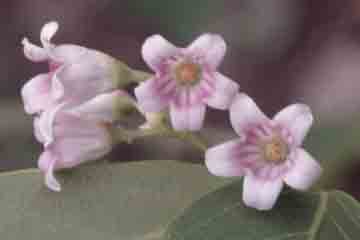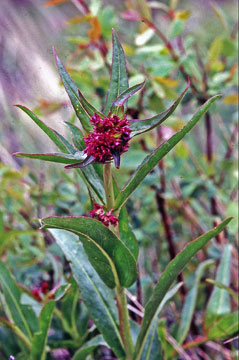


* The term “axil” as used in this context refers to the upper angle where a leaf arises from the main stem. Cf. “axilla,” the anatomical word for the armpit.


Home | Next | Previous | Index | Purchase the book
Idaho Mountain Wildflowers
The Dogbane Family: Apiaceae
Recent taxonomic revisions have joined the dogbane family (Apocynaceae) with the milkweed family (Asclepiadaceae), retaining the former name for the combined family. There are obvious similarities between dogbanes and milkweeds. Both exude thick milky latex when injured, both have fiber-containing seedpods, and plants in both families contain poisons. As a result of the taxonomic change, the reconstituted dogbane family is considerably larger, made up of approximately 480 genera and 4,800 species. Most grow in the tropics; many are vines, some are trees. The combined family has considerable economic importance. The anti-hypertension drug reserpine is derived from the Rauwolfia tree; the anti-cancer drugs vincristine and vinblastine come from periwinkle plants (Vinca spp.); strophanthin, a cardiac stimulant, is extracted from species of Strophanthus. Others are important ornamentals including species of milkweed ( spp.), oleander (Nerium spp.), periwinkle, and the frangipangi tree (Plumeria) to list a few. The family also produces timber from trees, fiber for cordage, and latex derivatives for various uses. Milkweed” and “dogbane” are old terms. The OED’s citations are from 1598 for milkweed and a year earlier, 1597, for dogbane, citing Gerard’s Herbal for the latter; “Dogs bane is a deadly and dangerous plant, especially to fower footed beasts.”
|
Spreading dogbane, Apocynum androsaemifolium L.: (left, right)The spreading dogbane is a loose vine-like plant that spreads along dry ground, blooming in mid-summer. It is commonly found in the open shade of evergreen forests from mid-elevations to sub-alpine slopes and is easily identified by its growth habit, by its bright green, smooth-surfaced, opposite leaves; and by its attractive little pink flowers with reflexed petals. Pick a leaf and you will see the distinctive thick white sap (latex) found in members of this family. Spreading dogbane grows throughout North America, excepting in several southern states as well as in Europe. Hemp dogbane or Indian hemp, Apocynum cannabinum, (not shown) is a related species found in all state sand in most Canadian provinces, usually at lower elevations. Native Americans used the fuzzy fiber contained in the plant’s seed pod to make cordage, explaining its common names. |
|
|
Narrow-leaf Milkweed, Asclepias
fascicularis Dcne.: The
narrow-leaf milkweed is a western plant, found in Idaho–where it seems
to be uncommon–in Utah and westward to the Pacific coastal states. The
plant may be identified by its narrow, opposite leaves and by two or more
crowded umbels of dark, reddish-purple flowers borne on short stems arising
from the axils of upper leaves*. The fruit (not shown) is a long pod. the
species name, fascicularis, from the Latin, means “clustered”
referring to the flowers.
* The term “axil” as used in this context refers to the upper angle where a leaf arises from the main stem. Cf. “axilla,” the anatomical word for the armpit. |
|
|
Showy Milkweed, Asclepias speciosa Torr.:(left, right) The showy milkweed’s range extends eastward from the Pacific coastal states to midwestern United States and Canada. The plant grows on moist soil and along slow moving waterways. Its general appearance, its attractive flower clusters, and later the typical milkweed pods (right) makes the plant easy to identify. The genus Asclepias is named for the Greek physician and minor deity, Aesculapius. The plant’s species name, speciosa, is from the Latin and means “showy” or “handsome.” |
|
Home | Next | Previous | Index | Purchase the book